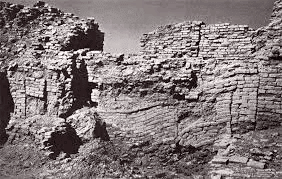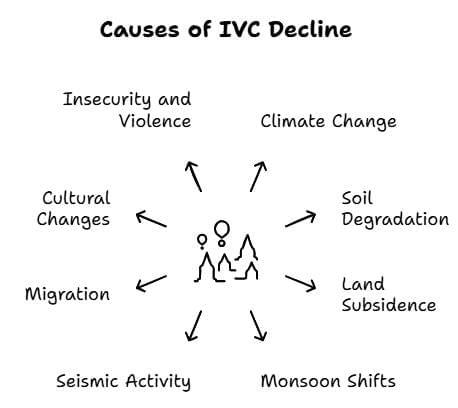Decline of Indus Valley Civilisation (IVC) | History for UPSC CSE PDF Download
| Table of contents |

|
| Decline of Indus Valley Civilisation |

|
| Decline of IVC - Causes |

|
| Theories of Decline |

|
| Aryan Invasion |

|
| Factors in the Decline of Harappan Civilisation |

|
| Decline of Trade |

|
Decline of Indus Valley Civilisation
- There is evidence that by around 1800 BCE, most Mature Harappan sites in places like Cholistan had been abandoned.
- At the same time, there was a rise in population in new areas like Gujarat, Haryana, and western Uttar Pradesh.
- Many scholars believe that climatic change was to blame for the fall of the Indus Valley Civilization.
- Some scholars believe that the drying of the Saraswati River, which began approximately 1900 BCE, was the primary cause of climatic change, while others believe that a large flood hit the area.
- Various elements of the Indus Civilisation have been discovered in succeeding cultures, indicating that the civilization did not vanish suddenly owing to an invasion.
- Many researchers believe that changes in river patterns caused the big civilisation to disintegrate into smaller settlements known as late Harappan civilizations.
 Decline of Indus Valley Civilization
Decline of Indus Valley Civilization
Decline of IVC - Causes
The decline of the Indus Valley Civilization (IVC) is attributed to several factors:

1. Environmental and Climatic Changes
- Climate change, deforestation, extreme flooding, river shifting and/or drying up, and misuse of the terrain are all examples.
- One reason is the decreasing fertility of the soil, caused by the rising salinity due to desert expansion.
- Another cause may be a sudden subsidence or uplift of the land, resulting in floods.
- Eastward-moving monsoons, or winds that produce heavy rains, might have been another calamitous alteration in the Harappan climate.
- Monsoons may be beneficial or harmful to a climate, depending on whether they sustain or destroy flora and crops.
2. Migration and Socioeconomic Effects
- By 1800 BCE, the Indus Valley temperature had become colder and drier, and a seismic event may have redirected or disturbed river systems, which were the Indus Valley Civilization's lifelines.
- The Harappans might have migrated eastward to the Ganges basin, where they might have established villages and isolated farms.
- These little towns would not have been able to create the same agricultural surpluses that huge cities require.
- Trade with Egypt and Mesopotamia would have suffered as a result of diminished products output.
3. Cultural Changes and External Influences
- There are signs of cultural changes, indicated by the slow influx of new peoples into the Indus basin during the later stages of Harappan culture.
- Evidence of insecurity and violence appears in the last phase of Mohenjo-Daro, such as: Buried jewellery and huddled skulls.
4. New Pottery Styles and Vedic Links
- New pottery styles were found at some Harappan sites in Baluchistan, including Painted Grey Ware, which was typically linked to the Vedic people.
- This influx of new people is thought to be linked to barbarian horse-riding groups from Iran.
- However, these newcomers did not arrive in sufficient numbers to completely overrun the Harappan cities in Punjab and Sindh.
5. Harappan Legacy and Gradual Decline
- Although the Rig Vedic Aryans predominantly settled in the region of the Seven Rivers, where the Harappan culture thrived, there is no evidence of large-scale conflict between them.
- The Harappan culture persisted, albeit weakened, in the peripheral areas such as Gujarat, Rajasthan, and western Uttar Pradesh.
- By roughly 1700 BCE, most of the towns of the Indus Valley Civilization had been abandoned.
Theories of Decline
- Some believe the decline of the Harappan civilisation was due to reduced fertility from increasing soil salinity, which resulted from the expanding desert nearby.
- Others suggest that the Harappan culture was wiped out by the Aryans.
- One of the most credible arguments for the Harappan civilization's demise is that it was devastated by enormous floods.
- That the loss occurred as a result of river course changes and the progressive drying out of the Ghaggar-Hakra river system.
- During the later stages of the Harappan culture, unusual tools and pottery suggest the gradual arrival of new groups in the Indus basin.
- In the final phase of Mohenjo-daro, there are signs of insecurity and violence, with jewellery buried in various locations and skulls found together in one spot.
- Although the Rig Vedic Aryans mainly settled in the land of the Seven Rivers, where the Harappan culture once thrived, there is no evidence of large-scale conflict between the Harappans and the Aryans.
Aryan Invasion
 Aryan's Route
Aryan's Route
- Initally, Ramaprasad Chanda proposed the concept that the civilisation was destroyed by Aryan invaders, but he later altered his opinion, and Mortimer Wheeler expanded on it.
- Wheeler thought that the Aryan invasion annihilated the Harappan civilisation.
- Wheeler cited human skeleton remains discovered in the late stages of occupancy at Mohenjodaro as evidence of the Aryan slaughter.
- Wheeler referred to mentions in the Rig Veda of various types of forts and attacks on walled towns as signs of conflict, but these references should not be taken as clear proof of an invasion.
- The Rig Vedic Aryans' habitation area encompassed the Punjab and the Ghaggar-Hakra region.
- Wheeler assumed the Harappan towns were being mentioned in the Rig Veda because no other cultural groups had forts in this area during this historical period.
Factors in the Decline of Harappan Civilisation
The decline of the Harappan civilisation has been linked to several reasons, including:

Natural Disasters
- Natural disasters were likely a significant factor in the decline of the Harappan civilization, although they may not have been immediate or isolated events.
- Evidence of silt deposits in various Indus towns, including Mohenjodaro, Chandraketugarh, and Lothal, suggests destruction caused by rising rivers.
- Several layers of silt at Mohenjodaro show that the city was impacted by successive Indus floods, which led to the collapse of Harappan civilisation.
- Evidence of significant flooding appears to have separated distinct periods of occupancy in Mohenjodaro.
- The fact that the homes and streets of Mohenjodaro were repeatedly covered with silty clay and crumbled construction debris suggests this.
- The flood waters that had inundated the streets and houses appear to have left this silty clay behind.
- After the floodwaters subsided, the residents of Mohenjodaro rebuilt dwellings and streets on top of the wreckage from the old structures.
- This type of catastrophic flooding and subsequent reconstruction appears to have occurred at least three times.
- M. R. Sahni, subsequently followed by Robert L. Raikes and George F. Dales, suggested that the floods at Mohenjodaro were caused by human error.
- Tectonic movements were to blame.
- According to one idea, the Indus region is a seismically disturbed area, and tectonic movements resulted in the formation of a massive natural barrier that kept the Indus from flowing towards the sea. transforming the region surrounding Mohenjodaro into a massive lake.
Ecological Imbalance
- Scholars like Fairservis have attributed the decline of the Harappan civilization to environmental and social problems, such as decreasing soil fertility caused by increased salinity from the expanding desert.
- Fairservis proposes that the civilisation fell because the expanding number of people and cattle could not be maintained by resources within the Harappan cultural zone, using current statistics to estimate population, land, food, and fodder requirements.
- So because human and cattle populations in these semi-arid areas were rapidly depleting the few trees, food, and fuel supplies, the delicate ecological balance of these semi-arid places was being disrupted.
- Others believe that sudden changes in the land's elevation caused flooding, while some argue that the Harappan culture was overrun by the Aryans.
- Over-cultivation, overgrazing, and excessive tree cutting for firewood and farming were all examples of Harappan over-exploitation of the environment.
- The combined requirements of Harappan townspeople, peasants, and pastoralists outstripped these places' limited production capacity.
- As a result, the landscape was worn out by an increasing population of human and animals confronted with limited resources.
- This would have resulted in the progressive disappearance of forests and grasslands, as well as decreased soil fertility, floods, droughts, and increased soil salinity.
Shifting Away of Indus
- According to Lambrick, changes in the path of the Indus River may have led to the decline of the Indus Valley civilization.
- The Indus is a shaky river system with a constantly moving bed.
- The Indus River relocated thirty kilometres away from Mohenjodaro, according to reports.
- Due to a lack of water, residents of the city and the adjacent food-producing villages fled the region.
- This happened several times throughout Mohenjodaro's history.
- The silt seen in the city is the result of a lot of sand and silt being blown in by the wind.
- This, in combination with crumbling mud, mud brick, and baked brick constructions, resulted in silt that was mistaken for flood silt.
Climatic Change
- While Mohenjodaro may have deteriorated due to natural floods, Harappan sites in the Ghaggar-Hakra valley faced ongoing drying out.
- According to D.P. Agarwal and Sood, the Harappan civilisation fell when the region became more arid and the river Ghaggar-Hakra dried up.
- They discovered that by the middle of the second millennium B.C., dry conditions had increased.
- Even a little loss in moisture and water availability in semi-arid locations like the Harappa might spell tragedy.
- It would have an impact on agricultural productivity, putting city economies under strain.
Decline of Trade
- The decline in the lapis lazuli trade with Mesopotamia, as noted by Shereen Ratnagar, contributed to the downfall of the Harappan civilisation. Interaction with Mesopotamian cities may have helped Harappan culture to develop.
- The Harappans traded with regions including Rajasthan, Afghanistan, and Iran, and their cities also had commercial ties with those in the Tigris and Euphrates areas.
- Numerous Harappan seals have been found in Mesopotamia, suggesting that the Harappans copied some cosmetics from the urban population there.
- Mesopotamian records from around 2350 B.C. mention trade relations with Meluha, which is the ancient name for the Indus region.
- The structure of Harappa spans 5 km, making it the largest of its kind in the Bronze Age. No other urban complex of Harappan size has been discovered to date.
Many factors behind the decline of the Harappan civilisation are still unclear. Many experts think that climatic change was to blame for the fall of the Indus Valley Civilization. Most Harappan towns had been nearly totally abandoned by 1800 BCE. The communities in the foothills eventually declined as well. Some scholars believe that the drying of the Saraswati River, which began approximately 1900 BCE, was the primary cause of climatic change, while others believe that a large flood hit the area.
|
216 videos|855 docs|219 tests
|
FAQs on Decline of Indus Valley Civilisation (IVC) - History for UPSC CSE
| 1. What were the primary factors contributing to the decline of the Harappan Civilization? |  |
| 2. How did climate change impact the Harappan Civilization? |  |
| 3. What role did trade play in the stability of the Indus Valley Civilization? |  |
| 4. Were there any signs of social unrest within the Harappan Civilization before its decline? |  |
| 5. How do archaeological findings support theories about the decline of the Indus Valley Civilization? |  |
















